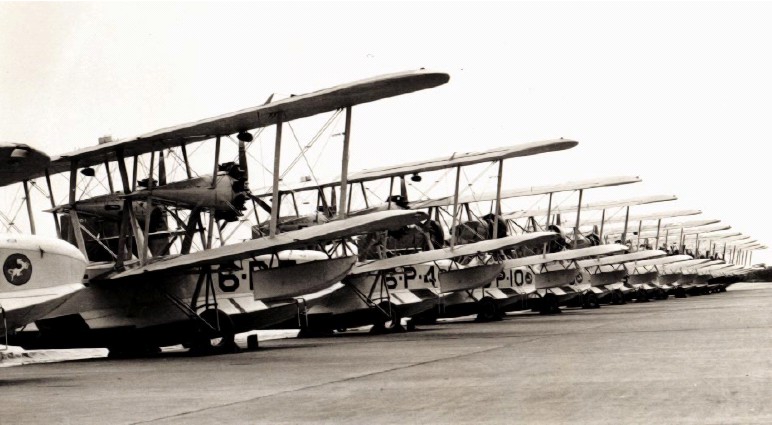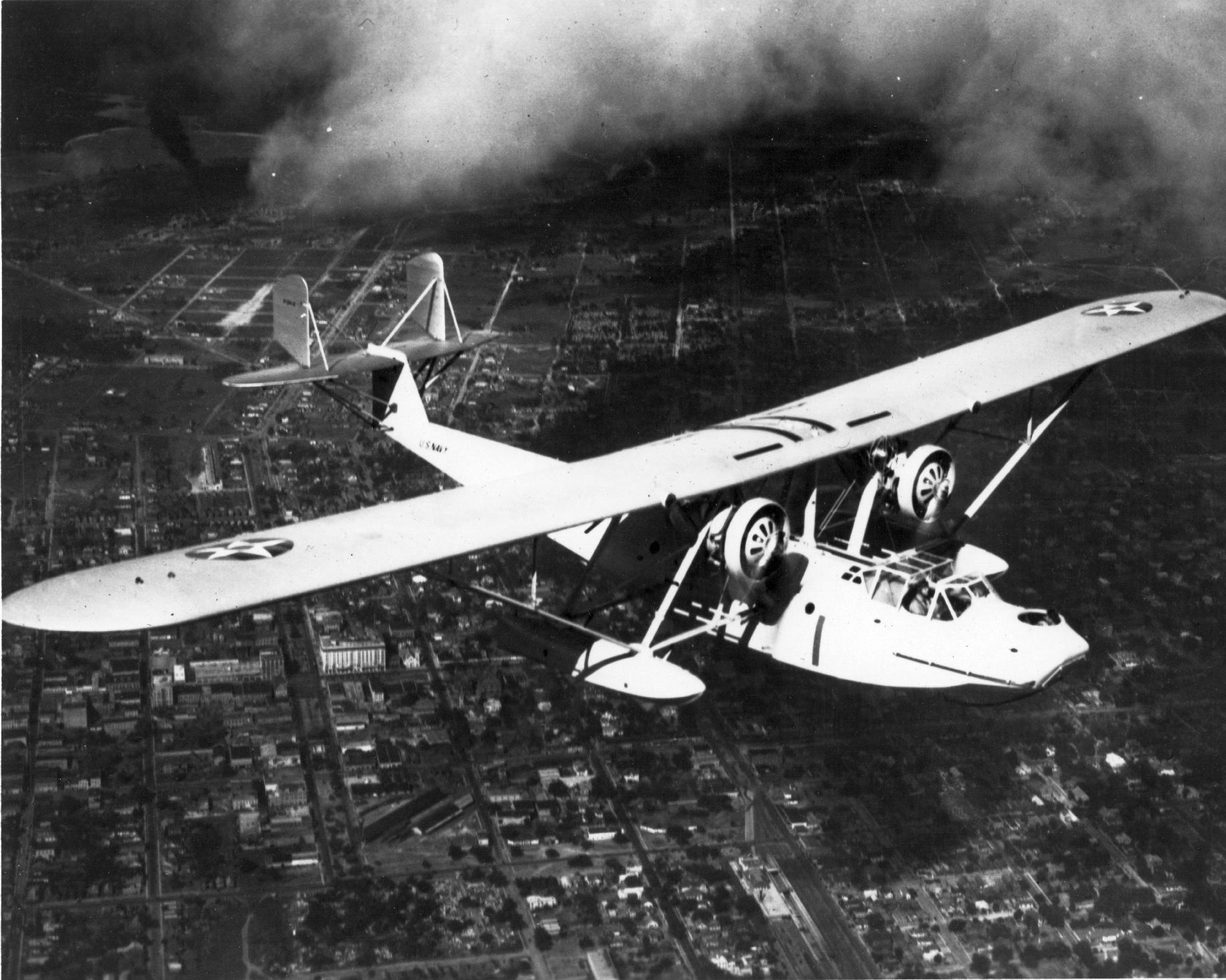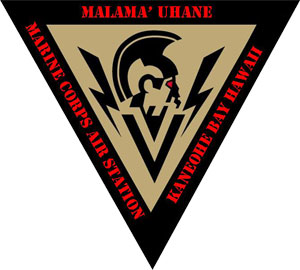|
VPB-11
VPB-11 was a Patrol Bombing Squadron of the U.S. Navy. The squadron was established as Torpedo & Bombing Squadron 19-D14 (VT-19D14) on 7 February 1924, redesignated Torpedo & Bombing Squadron 6D14 (VT-6D14) on 1 July 1927, redesignated Patrol Squadron 6-B (VP-6B) on 1 April 1931, redesignated Patrol Squadron 6-F (VP-6F) on 17 July 1933, redesignated Patrol Squadron 6 (VP-6) on 1 October 1937, redesignated Patrol Squadron 23 (VP-23) on 1 July 1939, redesignated Patrol Squadron 11 (VP-11) on 1 August 1941, redesignated Patrol Bombing Squadron 11 (VPB-11) on 1 October 1944 and disestablished on 20 June 1945. Operational history *7 February 1924: VT-19 was established as a torpedo squadron based at NAS Ford Island, Pearl Harbor, Hawaii, flying 13 DT-2 aircraft. *25 April 1925: Several of the squadron’s pilots made the first successful night landings on an aircraft carrier under way. The landings, made under varying lighting and weather conditions, were part of a program to determ ... [...More Info...] [...Related Items...] OR: [Wikipedia] [Google] [Baidu] |
VP-20
VP-20 was a Patrol Squadron of the U.S. Navy. The squadron was established as Patrol Squadron 8-S (VP-8S) from elements of VT-9S on 1 July 1929, redesignated Patrol Squadron 8-F (VP-8F) on 3 April 1933, redesignated Patrol Squadron 8 (VP-8) on 1 October 1937, redesignated Patrol Squadron 24 (VP-24) on 1 July 1939, redesignated Patrol Squadron 12 (VP-12) on 1 August 1941, redesignated Patrol Bombing Squadron 120 (VPB-120) on 1 October 1944, redesignated Patrol Squadron 120 (VP-120) on 15 May 1946, redesignated Heavy Patrol Squadron (Landplane) 10 (VP-HL-10) on 15 November 1946, redesignated Patrol Squadron 20 (VP-20) on 1 September 1948 and disestablished on 31 March 1949. It was the third squadron to be designated VP-20, the first VP-20 was redesignated VP-44 on 1 July 1940 and the second VP-20 was redesignated VPB-20 on 1 October 1944. Operational history *1 July – September 1929: A detachment of six aircraft and crews from VT-9S were used to provide the cadre for the establis ... [...More Info...] [...Related Items...] OR: [Wikipedia] [Google] [Baidu] |
VP-22
VP-22 was a Patrol Squadron of the U.S. Navy. The squadron was established as Patrol Squadron 4D-14 (VP-4D14) on 15 September 1928, redesignated Patrol Squadron 4-B (VP-4B) on 21 January 1931, redesignated Patrol Squadron 4-F (VP-4F) on 17 July 1933, redesignated Patrol Squadron 4 (VP-4) on 1 October 1937, redesignated Patrol Squadron 22 (VP-22) on 1 July 1939 and disestablished on 18 April 1942, with the squadron assets merged with VP-101. Operational history *15 September 1928: VP-4D14 established at NAS Pearl Harbor, Hawaii, with the D14 representing the 14th Naval District. The squadron began operations with six H-16 seaplanes. Primary mission of the squadron was patrol and bombing in connection with the plan of defense for the Hawaiian Islands. *20 February 1929: Mechanics from the Wright Aeronautical Corporation arrived to begin alterations on the engines of the H-16 and new T2D aircraft. *28 February 1930: The first PD-1 aircraft was received by the squadron for testing ... [...More Info...] [...Related Items...] OR: [Wikipedia] [Google] [Baidu] |
VPB-29
VPB-29 was a Patrol Bombing Squadron of the U.S. Navy. The squadron was established as Pacific Air Detachment on 17 January 1923, redesignated Patrol Squadron 14 (VP-14) on 29 May 1924, redesignated Patrol Squadron 1-Naval District 14 (VP-1D14) on 21 September 1927, redesignated Patrol Squadron 1-B (VP-1B) on 1 July 1931, redesignated Patrol Squadron 1-F (VP-1F) on 15 April 1933, redesignated Patrol Squadron 1 (VP-1) on 1 October 1937, redesignated Patrol Squadron 21 (VP-21) on 1 July 1939, redesignated Patrol Squadron 1 (VP-1) on 30 July 1940, redesignated Patrol Squadron 101 (VP-101) on 3 December 1940, redesignated Patrol Bombing Squadron 29 (VPB-29) on 1 October 1944 and disestablished on 20 June 1945. Operational history *17 January 1923: Pacific Air Detachment, Naval Station Pearl Harbor, Navy Yard Pearl Harbor, Hawaii, was formed with a hodgepodge of aircraft types. Aircraft assigned to the new unit consisted of Felixstowe F5L, F-5L, Douglas DT, DT and Curtiss Model H, H-1 ... [...More Info...] [...Related Items...] OR: [Wikipedia] [Google] [Baidu] |
VPB-23
VPB-23 was a patrol bombing squadron of the U.S. Navy. The squadron was established as Patrol Squadron 10-S (VP-10S) on 1 July 1930, redesignated Patrol Squadron 10-F (VP-10F) on 17 July 1933, redesignated Patrol Squadron 10 (VP-10) on 1 October 1937, redesignated Patrol Squadron 25 (VP-25) on 1 July 1939, redesignated Patrol Squadron 23 (VP-23) on 1 August 1941, redesignated Patrol Bombing Squadron 23 (VPB-23) on 1 October 1944 and disestablished on 25 January 1946. Operational history *1 July 1930: Torpedo Squadron NINE-S ( VT-9S) was redesignated at NAS Hampton Roads, Virginia, and the assets of the squadron were utilized to form Patrol Squadron 10S under the operational control of the Scouting Fleet. *1 September 1930: The squadron's twin-float T4M torpedo bombers were turned in for PM-1 flying boats. Tender support for the squadron's six PM-1 aircraft was provided by . *8 February 1931: VP-10S participated in Fleet Problem XII with VP-8, VP-3 and VP-5 in the Caribbean. Sq ... [...More Info...] [...Related Items...] OR: [Wikipedia] [Google] [Baidu] |
VP-21
VP-21 was a Patrol Squadron of the U.S. Navy. The squadron was established as Patrol Squadron 7-B (VP-7B) on 23 July 1929, redesignated Patrol Squadron 7-F (VP-7F) on 1 July 1931, redesignated Patrol Squadron 7 (VP-7) on 1 October 1937, redesignated Patrol Squadron 11 (VP-11) on 1 July 1939, redesignated Patrol Squadron 21 (VP-21) on 1 February 1941 and disestablished on 18 April 1942, with the squadron assets merged with VP-101. It was the third squadron to be designated VP-21, the first VP-21 was redesignated VP-45 on 1 July 1939 and the second VP-21 was redesignated VP-1 on 30 July 1940. Operational history *23 July 1929: Patrol Squadron 7-B was established at NAS San Diego, California, with six NB-1 floatplanes from the assets of the disestablished squadron VN-7D11. VP-7B came under the operational command of the Battle Fleet. Tender support was provided at that time by . PD-1 aircraft soon replaced the NB-1s. Training of flight crews continued through February 1930. *26 Ju ... [...More Info...] [...Related Items...] OR: [Wikipedia] [Google] [Baidu] |
NAS San Diego
Naval Air Station North Island or NAS North Island , at the north end of the Coronado peninsula on San Diego Bay in San Diego, California, is part of the largest aerospace-industrial complex in the United States Navy – Naval Base Coronado (NBC), and the home port of several aircraft carriers of the United States Navy. The commanding officer of NAS North Island (NASNI) is also the Commanding Officer, Naval Base Coronado (NBC). As such, he or she commands or administers NASNI and seven other naval facilities: Naval Amphibious Base Coronado (NABC); Outlying Field Imperial Beach; Silver Strand Training Complex; Remote Training Site, Warner Springs; Mountain Warfare Training Camp Michael Monsoor; Camp Morena; and Naval Auxiliary Landing Facility San Clemente Island. NBC, with only its commands in the metropolitan San Diego area, brackets the city of Coronado from the entrance to San Diego Bay to the Mexican border. NAS North Island itself is host to 23 aviation squadrons and 80 ... [...More Info...] [...Related Items...] OR: [Wikipedia] [Google] [Baidu] |
Johnston Atoll
Johnston Atoll is an Unincorporated territories of the United States, unincorporated territory of the United States, currently administered by the United States Fish and Wildlife Service (USFWS). Johnston Atoll is a National Wildlife Refuge and part of the Pacific Remote Islands Marine National Monument. It is closed to public entry, and limited access for management needs is only granted by Letter of Authorization from the United States Air Force and a Special Use Permit from the U.S. Fish and Wildlife Service. For nearly 70 years, the isolated atoll was under the control of the United States Armed Forces, U.S. military. During that time, it was variously used as a naval refueling depot, an Johnston Island Air Force Base, airbase, a testing site for nuclear and biological weapons, a secret missile base, and a site for the storage and disposal of chemical weapons and Agent Orange. Those activities left the area environmentally contaminated, and monitoring continues. The island i ... [...More Info...] [...Related Items...] OR: [Wikipedia] [Google] [Baidu] |
NAS Kaneohe Bay
Marine Corps Air Station Kaneohe Bay or MCAS Kaneohe Bay is a United States Marine Corps (USMC) airfield located within the Marine Corps Base Hawaii complex, formerly known as Marine Corps Air Facility (MCAF) Kaneohe Bay or Naval Air Station (NAS) Kaneohe Bay. Most of the original contract work at Kaneohe had been completed when the Navy transferred what was undone to the Seabees of the 56th Naval Construction Battalion on 1 April 1943. The 112th CB was tasked with adding a second runway 400' x 5,000' to the airfield. That was completed by the men of the 74th CB. December 7, 1941, the Imperial Japanese Navy attacked the air station minutes prior to the attack on Pearl Harbor. Of the 36 Catalinas stationed here, 27 were destroyed and six others were damaged, along with 18 sailors who perished in the attack. The first Japanese aircraft destroyed in action were shot down at Kaneohe, along with Aviation Ordnanceman Chief Petty Officer John William Finn becoming one of the first Med ... [...More Info...] [...Related Items...] OR: [Wikipedia] [Google] [Baidu] |
394th Combat Training Squadron
The 394th Combat Training Squadron was a United States Air Force unit assigned to the 509th Operations Group until inactivated on 13 April 2018. It was stationed at Whiteman Air Force Base, Missouri. The mission of the squadron was to train Northrop Grumman B-2 Spirit aircrews, a mission now executed by the 13th Bomb Squadron. The 394th is the fourth oldest squadron in the United States Air Force. Its history dated to 5 May 1917 as the 4th Aero Squadron. The 394th Combat Training Squadron provided the 509th Bomb Wing with qualified, mission-ready B-2 and Northrop T-38 Talon pilots to support worldwide Joint Chiefs of Staff taskings until its inactivation in 2018. The 394th was also responsible for implementing all B-2 and T-38 formal training courses. The unit supervised and oversaw all T-38 operations and performed quality assurance for all maintenance and aircrew training devices, including weapon system trainers. Upon the 394th Combat Training Squadron's inactivation ... [...More Info...] [...Related Items...] OR: [Wikipedia] [Google] [Baidu] |
72d Test And Evaluation Squadron
The 72d Test and Evaluation Squadron is part of the 53d Wing at Eglin Air Force Base, Florida. The squadron is geographically separated but operated from Whiteman Air Force Base, Missouri. It conducts testing and evaluation of the B-2 Spirit aircraft. Mission The squadron is the focal point for executing operational test and evaluation of the $44.6 billion B-2 weapon system. The squadron evaluates the ability of the B-2 weapons system to support all major requirements and reports weapon system capabilities. The unit provides experienced operations, maintenance, engineering, and analysis personnel who plan and conduct ground and flight tests, and analyze, evaluate, and report on the effectiveness and suitability of B-2 logistics support, tactics and survivability, foreign military exploitation, weapons and mission planning. The squadron reports results and conclusions to support DoD acquisition, deployment and employment decisions. History World War I The squadron was ... [...More Info...] [...Related Items...] OR: [Wikipedia] [Google] [Baidu] |
VP-102
VP-102 was a Patrol Squadron of the U.S. Navy. It was established as VP-18 on 1 September 1937, redesignated as VP-13 on 1 July 1939, redesignated as VP-26 on 11 December 1939, redesignated as VP-102 on 16 December 1940 and disestablished on 18 April 1942. Operational history *1 September 1937–January 1938: VP-18 was established at NAS Seattle, Wash., by CNO and BuAer for administrative purposes. Formation of the squadron proceeded slowly, with official establishment ceremonies being held on 15 December 1937. The squadron did not receive its first aircraft until 15 January 1938, when 15 P2Y-3 seaplanes were transferred from VP-4. One, possibly two, PBY-1 aircraft were also part of the squadron complement for conversion training when more of the Catalinas became available. Although located at NAS Seattle during its formation, VP-18 came under the operational control of Patrol Wing-2, located at Naval Station Pearl Harbor, Hawaii. *25 March 1938: Aircraft of Patrol Wing 2 part ... [...More Info...] [...Related Items...] OR: [Wikipedia] [Google] [Baidu] |
Anti-submarine Warfare
Anti-submarine warfare (ASW, or in older form A/S) is a branch of underwater warfare that uses surface warships, aircraft, submarines, or other platforms, to find, track, and deter, damage, or destroy enemy submarines. Such operations are typically carried out to protect friendly shipping and coastal facilities from submarine attacks and to overcome blockades. Successful ASW operations typically involved a combination of sensor and weapon technologies, along with effective deployment strategies and sufficiently trained personnel. Typically, sophisticated sonar equipment is used for first detecting, then classifying, locating, and tracking a target submarine. Sensors are therefore a key element of ASW. Common weapons for attacking submarines include torpedoes and naval mines, which can both be launched from an array of air, surface, and underwater platforms. ASW capabilities are often considered of significant strategic importance, particularly following provocative instan ... [...More Info...] [...Related Items...] OR: [Wikipedia] [Google] [Baidu] |







